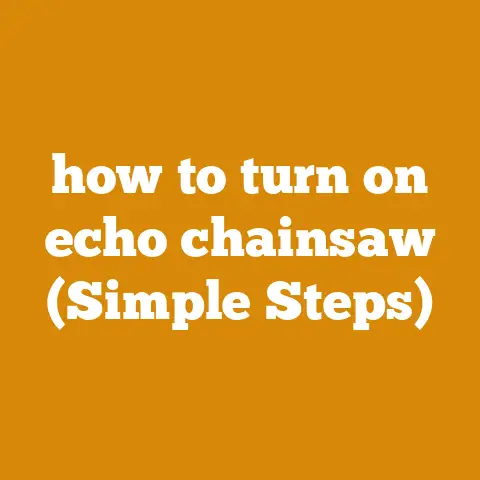How to Tell When Chainsaw Bar Is Worn Out (3 Warning Signs)
Ever thought about the resale value of your chainsaw? Yeah, it might not be the first thing on your mind when you’re out there tackling that stack of logs, but keeping your chainsaw in tip-top shape can really pay off. A well-maintained chainsaw not only performs better but also fetches a higher price if you decide to sell it down the road. One of the key components you need to keep an eye on is the chainsaw bar. So, how do you know when it’s time to replace it? Let’s dive into the three warning signs that your chainsaw bar is worn out.
1. Uneven Cutting
Imagine slicing through wood, expecting a nice, straight cut, but instead ending up with a wobbly mess. Frustrating, right? This could be a sign that your chainsaw bar is worn.
Why Does This Happen?
The chainsaw bar guides the chain, and if it’s worn, the chain might not travel in a straight line. This can lead to uneven cutting, which is not only annoying but can also be dangerous.
My Experience
I remember the first time I noticed this with my old chainsaw. I was cutting firewood for winter, and my cuts started looking like they were drawn by a toddler. I scratched my head for a while before realizing that my bar was the culprit.
What to Do
- Inspect the Bar: Look for visible wear and tear. If the edges are rounded or there are deep grooves, it’s time for a replacement.
- Check the Rails: The rails should be even. If one side is higher than the other, that’s a problem.
- Use a Straight Edge: Place it along the bar. If there are gaps, you’ve got a worn-out bar.
Safety Alert
Never ignore uneven cuts! It can cause kickback, which is dangerous.
In-Depth Look: Causes of Uneven Cutting
Uneven cutting can often stem from several underlying issues that aren’t immediately obvious. Let’s break these down:
- Misaligned Bar: Sometimes, the bar itself can become misaligned due to repeated impacts or improper installation. This misalignment can cause the chain to veer off course.
- Improper Tension: Tension that’s too tight or too loose can result in uneven cuts. Always ensure your chain is tensioned just right—like Goldilocks would want it.
- Worn Sprocket: A worn sprocket can create irregular movement in the chain, impacting the cut’s straightness.
Story from the Field
Let me share another story. A buddy of mine was working on a big project building a log cabin. He started noticing that his precision cuts were gradually turning into zig-zags. After some head-scratching and a few choice words, he checked and found his bar was worn down from years of heavy use without proper maintenance. A quick bar replacement later, his cuts were back to being laser straight.
2. Chain Keeps Jamming
Ever had your chain jam in the middle of a cut? It’s like hitting pause on a movie right at the most intense part—annoying and disruptive!
Why It Happens
A worn chain bar can cause the chain to pinch or bind, leading to frequent jams. This often occurs because the alignment and tension aren’t being properly managed by the worn bar.
Story Time
Back in my early days, I ignored this sign once. My chain jammed multiple times during a job, costing me precious time and making me look like an amateur in front of my crew.
Steps to Identify
- Observe the Chain: If it frequently derails or jams, inspect the bar.
- Feel for Tension: A worn bar might not hold tension well, causing the chain to slip.
- Check for Burrs: Sometimes burrs form on the bar, hindering smooth movement.
Safety First
A jammed chain can snap and cause injuries. Always turn off the chainsaw before attempting to fix a jam.
Detailed Troubleshooting: Chain Jamming
Understanding why your chain might be jamming involves dissecting various elements of your chainsaw’s operation:
- Debris Build-up: Often overlooked, debris accumulating in the groove of the bar can cause jams. Regularly clean out sawdust and wood chips from your bar’s groove.
- Chain Sharpness: A dull chain requires more force to cut through wood, increasing the chances of binding and jamming.
- Chain Quality: Not all chains are created equal. Using a low-quality chain can lead to more frequent issues with jamming.
Personal Insight
Once during a demo day at a local lumber supply store, I witnessed a rookie operator struggle with his saw continuously jamming. A quick inspection revealed it wasn’t just his technique but also a heavily worn bar contributing to his woes. We swapped it out on the spot—his jams disappeared instantly.
3. Excessive Wear on One Side
Notice one side of your chain is shinier than the other? That’s not just from being in direct sunlight; it might indicate excessive wear.
Reasons for Uneven Wear
This usually means your bar is bending or has an uneven surface that needs attention.
Personal Insight
I once salvaged an old chainsaw from my grandpa’s shed. It had excessive wear on one side because he always favored one direction while cutting—a classic case of operator-induced imbalance.
Diagnosing the Issue
- Examine Both Sides: Compare wear patterns on both sides of the bar.
- Feel for Flatness: Run your fingers along both sides; they should feel even.
- Look for Bends: A bent bar will cause uneven wear over time.
Warning Box
Using a bent or uneven bar can cause chains to break unexpectedly.
In-Depth Analysis: Uneven Wear Causes
Uneven wear might not just be an issue with how you’re cutting but also with what you’re using:
- Material Quality: Bars made from inferior materials tend to wear unevenly faster.
- Lack of Lubrication: Proper lubrication ensures even wear across both sides of the bar.
- Operator Habits: Consistent cutting angles and pressures can mitigate uneven wear over time.
Example Scenario
Consider this: You’re cutting through some dense oak logs but consistently find one side of your cut is smoother than the other. Upon inspection, you notice excessive wear on one side of your bar due to improper handling habits developed over years of casual use.
Prerequisites & Required Materials
Before tackling any maintenance or replacement tasks on your chainsaw bar, let’s ensure you have all you need:
- Chainsaw wrench
- Flat-file
- Straight edge
- Replacement chainsaw bar (if needed)
- Protective gloves
- Safety goggles
Prerequisite Knowledge:
- Basic understanding of chainsaw operation
- Familiarity with safety procedures
- Knowledge of basic tool usage
Safety Gear Reminder
Never forget your safety gear when handling tools—your eyes and hands will thank you!
Tips & Troubleshooting
Tip: Regularly clean your chainsaw bar to avoid premature wear. Dirt and debris can accelerate damage.
Troubleshooting: If cuts are still uneven after replacing the bar, check the chain tension or consider replacing your chain as well.
Conclusion & Next Steps
Keeping your chainsaw in good condition not only extends its life but also keeps you safe while working. If you notice any of these warning signs, take action immediately. Regular maintenance can save you headaches down the road and ensure every cut is as smooth as butter.
FAQs
Q: How often should I replace my chainsaw bar?
A: It depends on usage but generally every couple of years with regular use.
Q: Can I repair a worn chainsaw bar?
A: Minor issues can be filed down, but major wear often requires a replacement.
Q: Why does my chainsaw keep cutting to the left/right?
A: This is often due to uneven wear on one side of the bar or improper alignment.
By keeping an eye out for these signs and maintaining your equipment regularly, you’ll ensure that your chainsaw stays reliable and safe for all your cutting needs!






